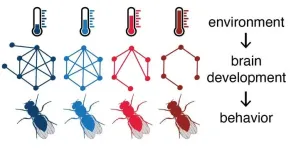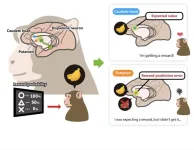(Press-News.org) Results indicate the closer the Doomsday Clock ticks to midnight, the higher the rates are for mortality specific to Alzheimer’s disease, suicide, unintentional injuries, alcohol and substance-related disorders
Since 1947, the Bulletin of the Atomic Scientists (BAS) has used the metaphor of the Doomsday Clock as a means of communicating how close the human species is to self-imposed annihilation, represented as midnight. While early iterations of the clock focused more exclusively on the dangers of nuclear weapons, the BAS has also begun to consider other evolving existential dangers in recent decades, including climate change, disruptive technology and cyber risks, and political volatility. The Doomsday Clock is both famous and controversial. However, to date no known studies have explored the potential connection between the Doomsday Clock and health and mortality.
A new study by researchers at Mass General Brigham investigated the mortality and mental health correlates of the iconic Bulletin of the Atomic Scientists’ Doomsday Clock, using data published by the United States Centers for Disease Control and Prevention (CDC) and the University of Washington’s Institute for Health Metrics and Evaluation’s (IHME 2023) Global Burden of Disease project. The authors describe the work as an initial approach to understanding the connection between the Doomsday Clock and human and mental health, opening the door for more conversations around how social determinants of health (SDOH) may influence people’s wellbeing, which in turn may influence broader events. Results are published in The Bulletin of the Atomic Scientists.
“This study represents a first step, with the inherent limitations thereof, but it suggests a bridge between the fate of the world, our psychology, and our health,” said first author Samuel Justin Sinclair, PhD, director of the Psychological Assessment and Research Service (PARSe) and a faculty member in the Department of Psychiatry at Brigham and Women's Hospital (BWH), a founding member of Mass General Brigham. “This may sound intuitive, but it’s something that no one has looked at before. We hope it opens the door to further discussion.”
The study’s results indicate that Doomsday Clock settings closer to midnight (indicating greater risk) are associated with higher mortality from Alzheimer’s disease, suicide, unintentional injuries, and alcohol and substance-related disorders. Conversely, the researchers also observed lower mortality rates for malignant neoplasms, HIV, and diabetes mellitus as the clock ticked closer to midnight.
According to the authors, the findings indicate that during periods of greater risk to society, there may also be corresponding variations in mortality and health and that socio-political indicators such as the Doomsday Clock may be useful in capturing aspects of social determinants of health on a macro level.
“The wellbeing and functioning of individuals, societies, nations, international affairs, our species, and our planet are interrelated,” says senior author David Silbersweig, MD, chairman emeritus of the BWH Department of Psychiatry. “Further studies can address the complex, multi-directional interactions so as to address large-scale challenges and inform policy.”
Authorship: Samuel Justin Sinclair and David A. Silbersweig.
Disclosures: Silbersweig is a co-founder and SAB chair for Ceretype Neuromedicine (unrelated to this submission).
Funding: None
Paper cited: Sinclair JS et al. “Apocalypse now? Mortality and mental health correlates of the Doomsday Clock” Bulletin of the Atomic Scientists DOI: /10.1080/00963402.2024.2439762
###
About Mass General Brigham
Mass General Brigham is an integrated academic health care system, uniting great minds to solve the hardest problems in medicine for our communities and the world. Mass General Brigham connects a full continuum of care across a system of academic medical centers, community and specialty hospitals, a health insurance plan, physician networks, community health centers, home care, and long-term care services. Mass General Brigham is a nonprofit organization committed to patient care, research, teaching, and service to the community. In addition, Mass General Brigham is one of the nation’s leading biomedical research organizations with several Harvard Medical School teaching hospitals. For more information, please visit massgeneralbrigham.org.
END
Second-hand electric cars may be close to a “tipping point” where they become more popular than equivalent petrol and diesel cars in the UK, new research shows.
Researchers analysed data from car sales website Auto Trader, comparing daily views of adverts for electric vehicles (EVs) with petrol/diesel cars.
Interest in second-hand EVs grew rapidly, doubling from 3.5% of advert views in 2022 to 7% in 2023.
Importantly, interest in EVs became more “sticky”. Events such as petrol price increases drove extra EV views – and over time these spikes of attention lasted longer and longer.
“To identify ...
A new study revealed significant differences in the appearance and behaviour of the two one-horned Asiatic rhinoceros species, challenging long-standing classifications and supporting a re-evaluation of their status.
The study, led by zoologist Francesco Nardelli and paleontologist Kurt Heißig, highlights how millions of years of evolutionary pressures have shaped the distinct adaptations of the Indian (Rhinoceros unicornis) and Sundaic (Rhinoceros sondaicus) rhinoceroses. The critically endangered Sundaic rhinoceros has a slender skull, a broader and lower back of the head, and a shorter nose and teeth suited for browsing leaves. In contrast, the ...
Most people are familiar with loopholes. When your boss, landlord, partner, customer, or government asks you to do something you don’t want to do, and yet you can’t say “no,” you may resort to malicious compliance – doing what someone asked, but not actually what they meant. Most parents are probably familiar with such “little lawyer” behavior too: if a parent says, “Time to put the tablet down,” a child might physically put the tablet down on the table – and then keep playing on it. While such ...
Sleep quality is a crucial aspect of health, yet while adults spend around a third of their lives sleeping, there is surprisingly little research on mattresses. Mass General Brigham researchers developed and tested the Boston Mattress Satisfaction Questionnaire (BMSQ), a new tool to rigorously assess mattress satisfaction and characteristics.
They administered the BMSQ to a representative sample of over 1,000 adults in the United States, finding that the tool is internally consistent and viable for assessing mattress ...
Recent studies on economic growth report that preventing the abuse of state power through democratic institutions is critical to a nation’s development. However, there has been little prior research on how societies transition in response to the two conflicting goals of limiting the state’s stranglehold on governance while improving its administrative capacity through citizens’ political participation.
Osaka Metropolitan University Associate Professor Ryosuke Okazawa of the Graduate School of Economics led a team that ...
The Smart 3D Printing Research Team at KERI, led by Dr. Seol Seung-kwon, has developed the world’s first technology for printing high-resolution 3D microstructures using 'MXene,' a material known as the dream material.
MXene, first discovered in the United States in 2011, is a two-dimensional nanomaterial composed of alternating metal and carbon layers. MXene possesses high electrical conductivity and electromagnetic shielding capabilities. Due to its easy combination with various metal chemicals, MXene has gained significant attention ...
The rate of development of poikilothermic animals, such as insects, fish, and reptiles, is determined by environmental temperature. A research team at Johannes Gutenberg University Mainz (JGU) has recently demonstrated how temperature can affect brain development in fruit flies. "In the area of the brain we examined, neurons formed more synapses and connected to more synaptic partners at lower temperatures," stated Dr. Carlotta Martelli, head of the team at the Institute of Developmental Biology and Neurobiology of JGU. In their study, the scientists focused on the olfactory circuit of Drosophila melanogaster, because the sense of smell determines important behavioral patterns in ...
CLEVELAND, Ohio (March 12, 2025)—Multiple menopause symptoms can make women feel fatigued. Hot flashes, sleep problems, pain, and depression are just a few. A new study suggests that heavy or prolonged menstrual bleeding may increase fatigue, which helps to explain why midlife women are two-to-four times more likely to experience debilitating forms of syndromic fatigue. Results of the study are published online today in Menopause, the journal of The Menopause Society.
Most women transitioning through ...
Kyoto, Japan -- We're all familiar with Pavlovian conditioning, in which a reward-anticipatory behavior follows a reward-predicting stimulus. Perhaps you experience it yourself when passing a café or restaurant and catching a whiff of something delectable.
Behind this mechanism is dopamine released within the striatum, the largest structure of the subcortical basal ganglia, which links motor movements and motivation. Yet it has remained unclear exactly what kind of dopamine signal is transmitted to the striatum to cause this behavior in primates.
In order to understand this dopamine signal, a team of researchers from Kyoto University ...
University of Maryland School of Medicine (UMSOM) researchers helped conduct an important new global health study that found a vaccine that protects against five strains of meningitis prevalent in sub-Saharan Africa is safe and effective for use in young children beginning at 9 months of age. This study provided evidence that formed the basis for the World Health Organization’s (WHO) decision last year to recommend the pentavalent Men5CV meningitis vaccine for infants ages 9 months and older.
Results of the study were published today in the journal Lancet.
In January 2024, the WHO recommended that all countries in the African meningitis belt introduce Men5CV into their routine immunization ...




